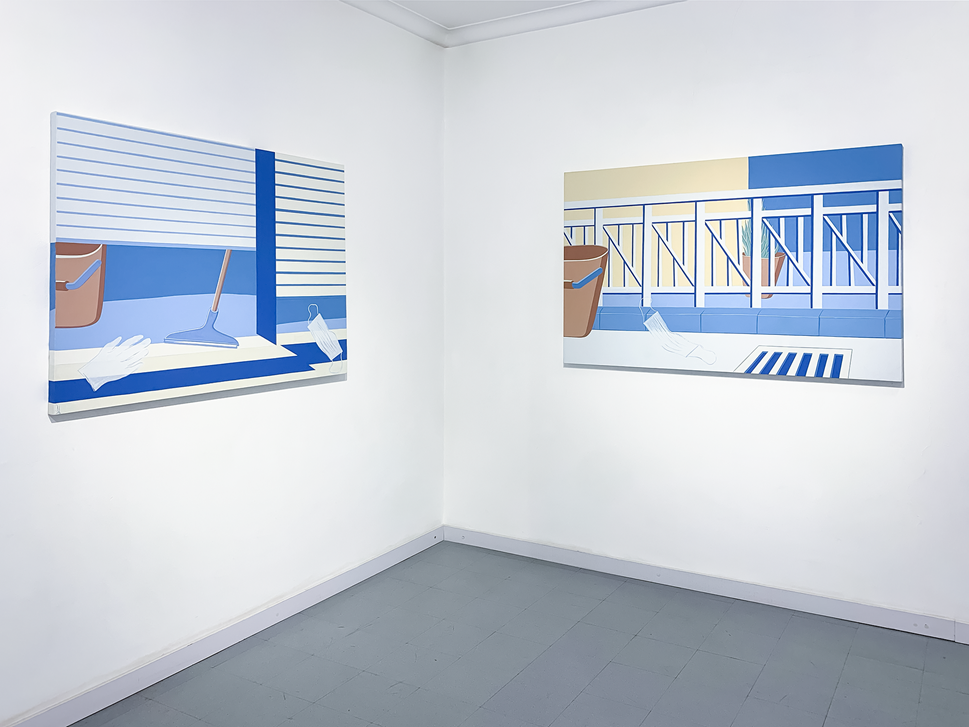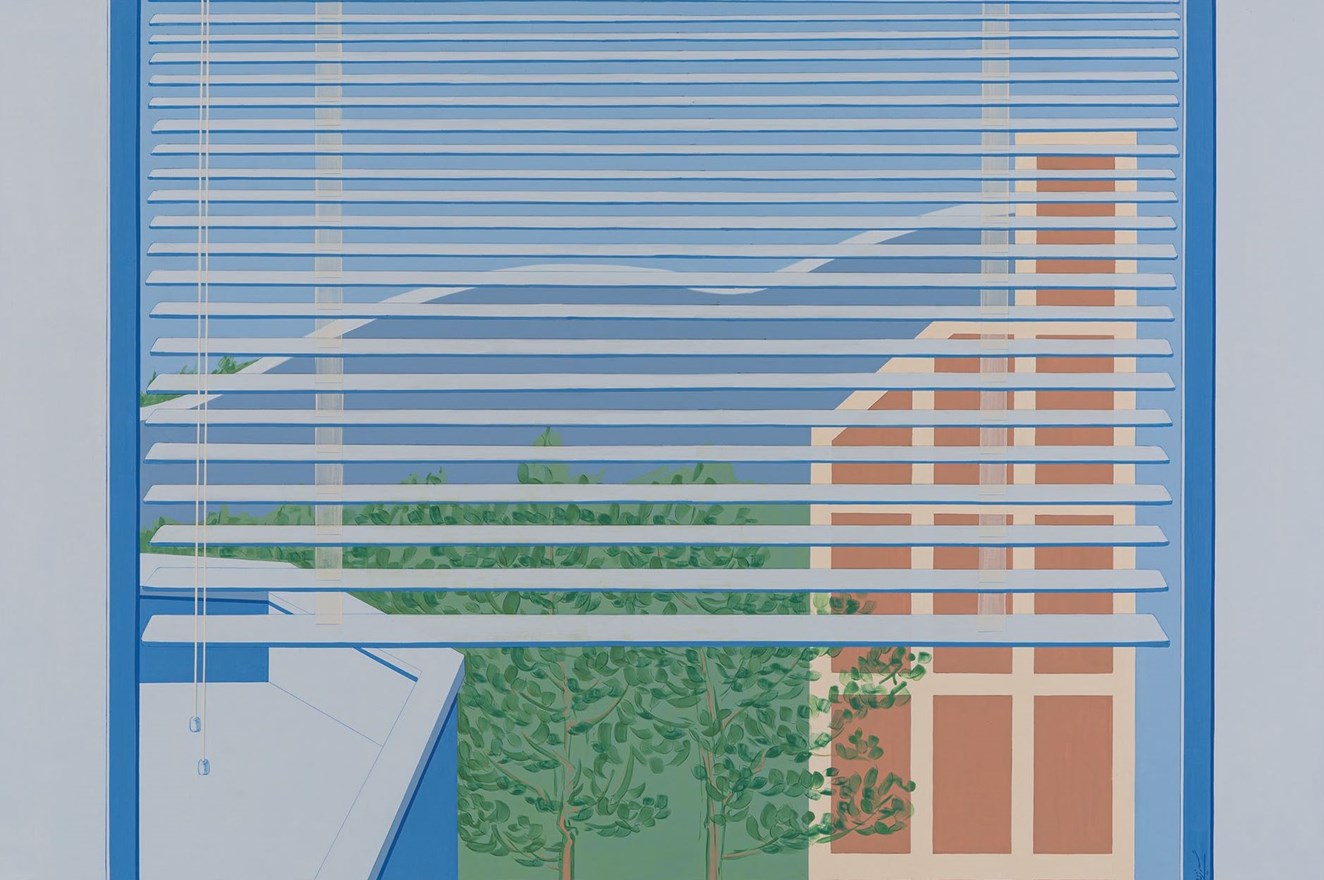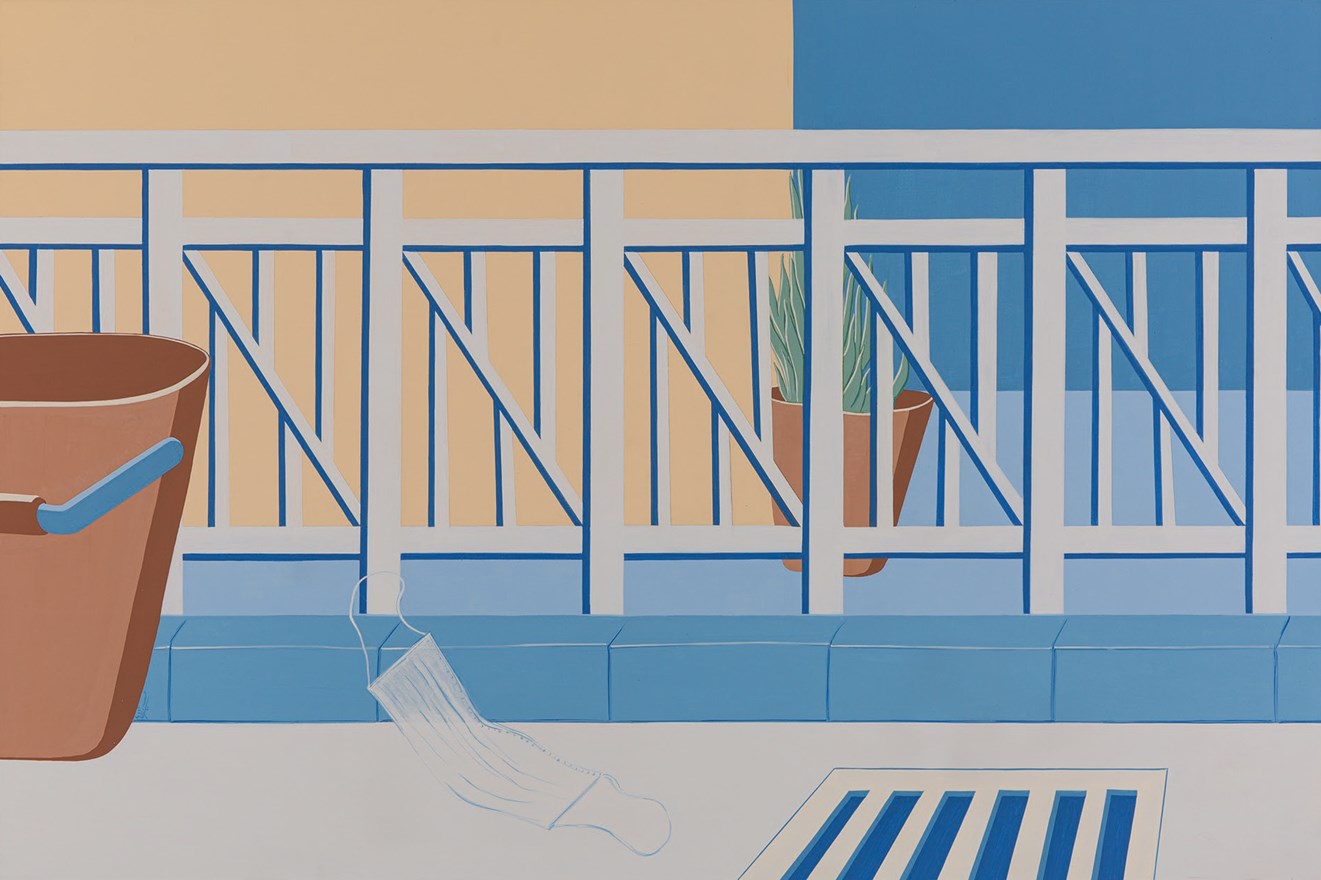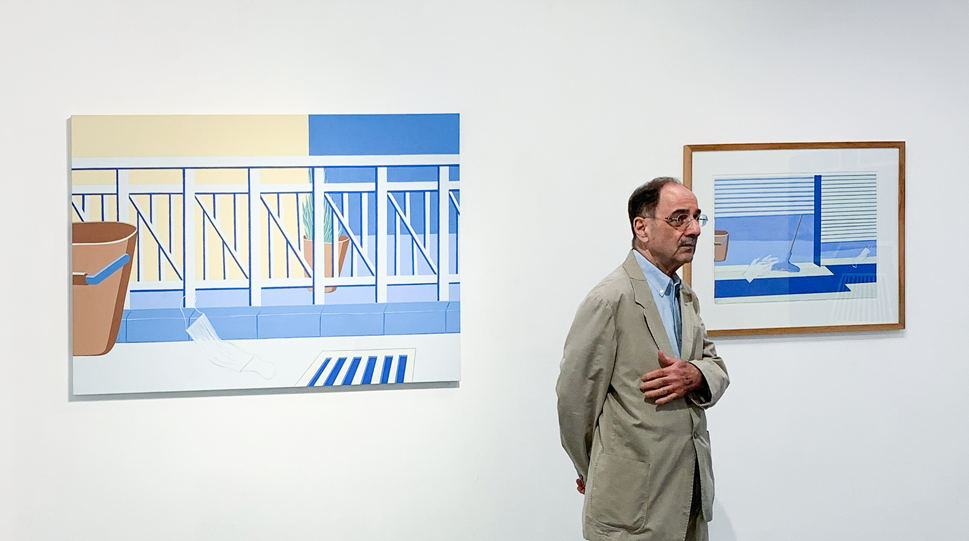In Search of Blues: Interview with Mehdi Hosseini
20 Jul 2022
On April 15, 2022, Mehdi Hosseini's paintings were exhibited at Hoor Art Gallery, Tehran. "Painting by Mehdi Hosseini" was held until May 6. So we talked to the artist to understand his thoughts, attitude, and different aspects of his paintings.
· Could you please explain the reason you arranged this exhibition?
These are the results of my work during the two years of the Coronavirus pandemic. They are, like my other works, minimalistic, and I tried to use as few elements as possible in order to create the subjective feelings and expression that I was looking for. I have created more of these paintings, but they are not displayed here. Not all of my attempts lead to good results. Most of them are not successful. Naturally, I excluded them and decided to exhibit the ones that match my feelings and thoughts. In these paintings, I have tried to make an interaction. I didn't want the viewer to just see a narrative through a painting and then go for the next one. Rather, I tried to arrange a series of elements in order to create a space for the viewers in which they can reflect on the works.

Mehdi Hosseini | Untitled | 2021 | acrylic on canvas | 100 × 100 cm
· You use a specific color palette in all of your works. Why is that? In other words, what is your background with this unique palette? Why did you start using these colors?
When we start to paint as teenagers, we experience working with a wide range of colors. So we have no idea what we are doing, we are just experimenting. But each one of us, who enters the realm of visual arts, will gradually find our career path; some choose to be a figurative painter, some others become abstract painters, decorative, geometric, etc. Artists will eventually choose not only their artistic style but also their own range of colors. After my initial experiences, I found my colors based on my introverted personality. Additionally, as I have mentioned before, being inspired by Iranian miniature paintings of Herat School, especially those presented in Baysonghor Shahnameh, has certainly influenced my color preferences. Fortunately, this version of Shahnameh is still kept in Golestan Palace, Iran.
I remember that in the 1950s, we were given the chance to visit museums and libraries as art school students, so we could see objects which dated back to different historical periods of Iran. Of course, there were not many museums then in Tehran. That was when I saw Baysonghor Shahnameh for the first time. They brought the book to us, and although they didn't let us touch it, they flipped through the pages so that we could see what is inside. I didn't notice what I had then taken from the book and how did its miniature paintings affect me. However, I think that was when I developed an interest in shades of grey.
After finishing art school, I moved to the U.S. and studied there for about seven years. I returned to Iran in 1971. At that time, Baysonghor Shahnameh had been published with a high-quality print, similar to the original one, and also in the same size. The book was published concurrently with the 2500-year celebration of the Persian Empire, and they were presented as gifts to the rulers of different countries. When I reviewed the book after what I had experienced during the years I was abroad, I realized that I had been affected by the miniature paintings of this book when I was in art school, and not just by their grey tonalities, but also by their interactive space, mystical atmosphere and the dominant role of geometry in them. In these [miniatures] there is neither a narrative nor the name of the painter. But of course, we can recognize who painted each one of them. So here, the artist narrates through depicting a certain atmosphere and mood; something I didn't understand when I first saw Shahnameh. But with some twelve years of experience, I had acquired. I became aware of this quality once I reviewed the book. This [effect] has remained with me ever since. Since I returned to Iran, I have constantly followed this attitude in all my works and exhibitions.

Mehdi Hosseini | Untitled | 2021 | acrylic on canvas | 100 × 150 cm
· Blue is obviously the dominant color in this exhibition. What does this color remind you of?
Naturally, blue, dark blue, and greys with a blue tint are usually associated with introverted personalities. When I decided to create an interactive space in my exhibition, I came up with these colors; beige, dark blue, blue, blue-grey. On the contrary, I ignored colors like cadmium, maroon, and orange, which are invasive and related to extroverted personalities. I didn't want to impose a certain feeling on the viewer. Instead, I want the viewers to stand in front of my work and receive the impression on their own. Therefore, I use blue colors – dark or bright.
Another thing to mention is that I am always influenced by the miniature paintings of Herat School and its dominant geometric properties; this might not be clearly visible here though. On the other hand, in [second] Tabriz School, or as it is also called Safavi School, brighter and more moving colors are usually used. So here, the presence of blue, as the dominant color is certainly because I am influenced by Herat School. The colors in my paintings associate with the colors used more than five hundred years ago, but my paintings deal with contemporary subjects.
· There is a prominent "spatial" aspect to your works. I would like to know about your approach to the "representation of space" in your paintings.
Modern painting doesn't narrate stories. It tries to present thoughts and an outlook on the world through the way it represents space. This is also the case in the medium of film. By watching the best movies one can notice that their directors don't create chaotic narratives. They try to convey their message through creating space. Most of the great movies have simple, short scripts. Why? Because they don't want to attract the audience with expression, dialogue, and chaos. The audience understands the story through the created space. It is the same in drawing and painting. Even in graphics, we evaluate works as good designs if they attract the viewer by using as few expression and color elements as possible.
For example, in our domestic television programs, too many agents are included in the scene; but there is no efficiency, and they don't attract the audience at all. They would like to turn the television off or just ignore it. But when the program is carefully designed and scheduled, it can create an attractive space and the audience would like to sit and watch it. They don't want to turn off the television anymore. So this is really important. In the current century, time and space are the basic tools with which the artist can work in any field.

Mehdi Hosseini | Untitled | 2021 | acrylic on canvas | 100 × 150 cm
· You have used flat colors in your works and arranged them in an eye-catching composition. As the creator of these arrangements, how would you describe them?
When an artist starts to create an artwork, the work's final form is obviously not achieved yet. In the process of working, many elements are set aside, and many others are received and created through intuition. Therefore, space is created by selecting and omitting some elements, emphasizing some of them, and ignoring others. So the artist goes through a process of selection, imagination and depiction.
For instance, you see an image of a ditch, that all of us have previously seen moving past the ditch while riding a motorcycle or driving a car. There are also other elements, and this is important; which elements, that you think are in accordance with your introverted personality, would you include in the frame? Which ones could be combined and developed along with other elements, which could eventually be displayed?
· What is the story behind the masks that appear in some of your paintings?
This is what we all have experienced in the last two years; masks and disposable gloves left on the corners and on the sides of the street. Many people tell me "your works don't have any social aspect to them" ; however, I am always concerned with social matters in my work. My social concerns are expressed in an implicit, poetical way. So some of the elements visible in my works have originated from the space which we all have lived in and experienced.
Another example is the "snowy" one. Although last winter it didn't snow much in Tehran, we experienced some really cold days, and that made this painting snowy. So the snow is here in this painting because I painted it during those cold days. In other works, you may notice that the space is brighter; a space with trees covered in snow turned into a green, vernal space, and this obviously suggests the time during which I was painting it. In other words, the qualities of time are concisely apparent in these works.
· How is your daily routine planned as a painter?
Unlike most artists, who wake up late and go to work late [laughs], I have a normal living: I sleep at ten o'clock or sooner, and I wake up at about five or six o'clock in the morning. Then I eat breakfast, I exercise and then I start working until noon. These three or four hours in the morning are the most important hours of my time. I may work in the afternoon some days, but most of my painting is done in the morning. Some days I may need to attend a meeting, or I may become busy taking care of matters in some offices or organizations.
· And as the final question; in addition to working as an artist, you have worked as a teacher for a long time. I would like to know how these two fields of activity are related and how each has been affected by the other?
That is because of the way I was taught when I was abroad. When I was studying for the MA degree, the director of department told us: "currently, unlike the best artists around the world, you cannot sell your artworks and earn money. However, you should be able to depend on your own and at least, earn a living." Then according to the teaching method used there, he told us: "the only thing that you can do without harming your artistic activity, is to teach. Any other jobs can cause detrimental effects on your painting." Therefore, at Pratt Institute, courses were scheduled to make us spend most of our time painting; and for earning money, we were required to teach. Since we entered the institute, they taught us how to show up at a class. We accompanied professors to other classes and helped them. I suppose this was also part of a plan. Sometimes they called and said that they have to take care of some other task and that they cannot come to the class. They wanted to see if we can arrive at the class on time and direct it properly or not. Are we self-confident or not? I mean they tested us. Sometimes I felt that the professor is just making an excuse in order to test us.
Moreover, I was also interested in teaching. When I returned to Iran in 1971, I taught at Fine Art School both for girls and boys. In 1975, Farabi University – which is now closed – was being established. They evaluated me as qualified for teaching, based on the documents they had about me in the ministry of science. This happened not just in art, but in all majors; graduates returning to Iran were recognized to teach at universities. I taught at Farabi University until 1979. After the revolution, Farabi University was closed because of its connection to the royal family. So I stayed home for about four years. Then in 1983, when universities were reopened, we were asked to teach again.






